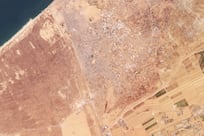Aleppo // Hundreds of civilians trying to flee heavy regime bombardment and fighting in rebel-held east Aleppo were forced back by gunfire, a monitoring group said on Wednesday as the government pressed its offensive to control the whole city.
“On Tuesday night, around 100 families gathered near a passage from the Bustan Al Basha district to cross to Sheikh Maqsud,” said Rami Abdel Rahman, director of the Syrian Observatory for Human Rights.
“But when the civilians tried to cross to the other side, gunfire broke out,” he said, without specifying who was responsible.
Sheikh Maqsud is a northern neighbourhood controlled by Kurdish forces, allied with neither the regime nor the rebels.
The governorate running western Aleppo city said 10 people who had managed to crossed from the east on Tuesday evening had accused rebels of preventing people from leaving, but gave no details on how or where the civilians crossed over.
The government has long accused rebels of using residents in the east as human shields. Rebel groups deny any coercion and say the regime is lying.
“This has nothing to do with reality,” said Yasser Al Youssef, from the rebel group Nureddine Al Zinki.
“The regime is spreading rumours to try to undermine the resolve of the rebels and those who support them in Aleppo,” he said.
A months-long siege by government forces has trapped more than 250,000 civilians in eastern Aleppo with dwindling food and fuel supplies as winter approaches.
On November 15 the Syrian army, backed by allied forces from Iran, Russia and the Lebanese militant group Hizbollah, launched a renewed assault on the city’s east, pounding the area with air strikes, barrel bombs and artillery fire.
The offensive has so far killed at least 143 civilians, among them 19 children. Rebel fire on the government-held west has killed 16 civilians, including 10 children.
Government bombardment of east Aleppo has destroyed hospitals and rescue centres, and forced schools to close. Medical officials said some of the barrel bombs dropped by the government appeared to contain chlorine gas. Both Damascus and its ally Moscow have strongly denied any illegal military use of the chemical.
Regime troops now control half of the strategic Masaken Hanano district in the north-east of the city, the Observatory said.
Capturing the district would give the army line-of-fire control over several other parts of east Aleppo while dividing it in two.
The renewed bloodshed has stoked international concern, though there has been little sign so far of a plan to halt it.
French foreign minister Jean-Marc Ayrault said on Wednesday that backers of Syria’s moderate opposition would meet in Paris in early December to discuss the situation.
He urged the international community to “stop averting its gaze” from the “terrible reality” of the conflict.
Save the Children called for an internationally monitored ceasefire to allow aid into east Aleppo and the evacuation of sick and wounded civilians.
“It is a moral outrage that the death toll of Aleppo’s children continues to grow and seems only set to get worse, whilst so little action is being taken to end the bombing and hold warring parties accountable,” said the charity’s Syria director, Sonia Khush.
Over the weekend, UN envoy Staffan de Mistura floated a humanitarian plan for Aleppo as well as a proposal for a truce.
The truce deal would have allowed the opposition administration in east Aleppo to remain in place, at least temporarily, in return for extremist fighters leaving.
But the government rejected it, insisting the state had to retake control as any alternative would “reward terrorists”.
Recapturing the east would give president Bashar Al Assad’s government perhaps its most important victory yet in a conflict that has killed more than 300,000 people since March 2011.
* Agence France-Presse





